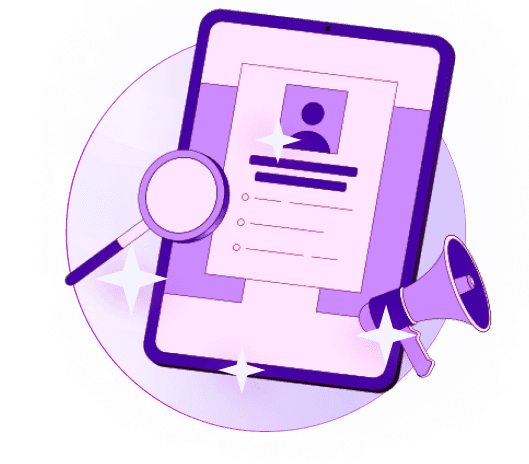Blogs
Articles

How to Generate Leads In Sales: A Step-by-Step Guide
85% of B2B marketers say their biggest challenge is generating sales leads.
Most marketing professionals struggle with the fundamental task that keeps their businesses running. The good news? A 20% boost in quality lead volume translates directly into 20% more income.
This piece will show you proven ways to generate sales leads. We'll cover everything from getting referrals (one of your best sources of quality leads) to using LinkedIn filters that help you find the right decision-makers. You'll get practical steps that bring results, whether you want to generate B2B leads or improve your current lead generation strategy.
What is a sales lead?
A sales lead is the life-blood of any successful sales strategy. A sales lead represents a potential customer who shows interest in your product or service and acknowledges a business problem you can help solve. These prospects drive your sales pipeline's growth through new customer acquisition.
Types of leads: cold, warm, and hot
Your customer's experience from prospect to buyer varies, which explains why we group leads based on their buying readiness:
Cold leads show little to no interest in your brand. They match your ideal customer profile but don't know about your offerings or what sets you apart from competitors. These leads need extensive nurturing before they're ready to buy.
Warm leads understand your product's benefits. They've connected with your business by subscribing to newsletters, browsing your website, or taking part on social media—yet they haven't decided to purchase.
Hot leads want to buy and make quick decisions. They know what they need, see how your solution helps them, and stand ready to act. These sales-qualified leads need minimal nurturing and convert more often.
Why lead quality matters more than quantity
Chasing more leads can mislead you. About 70% of businesses value quality leads over quantity, and with good reason too. The numbers tell the story:
Companies lose roughly $20,000 per sales representative annually on poor quality leads. Their average yearly loss reaches $180,000 on undeliverable direct mail alone. So, poor data quality costs U.S. businesses over $600 billion every year.
Quality leads convert up to 300% better than low-quality ones. A mere 5% increase in customer retention can boost profits by 25% to 95%. Lead quality proves crucial to your business's long-term success.
What is lead generation?
Lead generation turns consumer interest into sales by creating awareness about your products or services. This strategic method makes your sales cycle more productive by targeting the strongest prospects.
Lead generation starts by building awareness and interest. You might share educational content or connect with users through social media. People then volunteer their contact details through sign-ups, becoming potential leads.
Lead generation builds customer respect and positive relationships, not just numbers. Quality-focused lead generation helps you build stronger connections, achieve better conversion rates, and boost your business revenue.
What are the best ways to generate sales leads?
Quality lead generation needs a strategic approach, not random efforts. Let me share some proven strategies that will fill your sales pipeline with qualified prospects.
Ask for referrals
Your happy customers become your best promoters naturally. I always ask buyers if they know someone who might benefit from our products or services. This simple practice gets exceptional results quickly. Customer referrals are the easiest leads to convert because they come pre-qualified with trust. A well-laid-out program that rewards satisfied customers will maximize your referrals.
Nurture your leads
Most prospects need time before they convert. Lead nurturing means providing valuable resources that guide prospects through your sales funnel. You make authentic connections, understand pain points, and spot your most valuable prospects this way. Grouping customers with similar traits helps you personalize your message and adapt your approach.
Be a trusted source of information
You need to become an expert in your field and build trust with prospects and current customers. High-quality, informative content shows your authority and gives potential leads the information they need. Trade shows and conferences are a great way to get credibility as a trusted advisor instead of just another salesperson.
Email drip campaigns
Drip marketing uses automated, targeted emails to nurture potential customers. These campaigns build interest and engagement step by step. Drip campaigns work best when they respond to specific actions like clicking links or downloading resources. My results improve when I personalize content based on how recipients behave and what they prefer.
Social media marketing
Social media gives you access to huge audiences of potential customers and partners. LinkedIn posts reach specific locations, jobs, or industries—even without paid promotion. Three-quarters of consumers use social media to find products or new brands. Authentic messaging makes you stand out from competitors who use standard approaches.
Enable lead scoring
Lead scoring gives numerical values to leads based on their actions and engagement. Sales teams can focus on prospects more likely to convert, which saves time and resources. Your team meets sales targets faster by focusing on the most promising leads.
Website landing pages
Landing pages convert visitors into leads by encouraging specific actions. Your lead capture form should stay above the fold where visitors see it immediately. Customer testimonials, reviews, and security badges build trust in your brand.
Simplify lead gen forms
Each extra field in your form reduces completion rates. You should stick to fields that help convert leads into customers. Progressive profiling gathers information over time instead of all at once. Multi-step processes make longer forms feel simpler to complete.
Conclusion
High-quality sales leads are the lifeblood of any successful business. This piece explored proven strategies that work - from asking for referrals to simplifying lead capture forms. Quality trumps quantity in lead generation.
The experience from prospect to customer needs strategic planning and consistent execution. Companies waste $180,000 yearly on poor-quality leads, while high-quality leads can yield conversion rates up to 300% higher. Your energy spent on attracting and nurturing the right prospects will end up delivering better results.
The multi-channel approach we discussed brings the most important advantages. A combination of social media outreach, email drip campaigns, and targeted landing pages creates multiple touchpoints with potential customers. 87% of B2B decision makers research online before making purchasing decisions.
These strategies might seem overwhelming at first, but the results speak volumes. My team generated 42% more qualified leads last year by focusing on lead scoring and personalized nurturing sequences. You can achieve similar results with consistent application of these techniques.
Sales professionals seeking higher-quality leads and improved conversion rates can streamline their lead generation process with Persana.ai's powerful tools.
Lead generation works best without aggressive sales tactics or manipulation. Building genuine relationships, providing value, and solving real problems for prospects should be your focus. This mindset will help you increase sales and build a loyal customer base that stimulates long-term growth.
FAQ
How do you generate leads?
You can find leads through both online and offline channels. Online methods include:
SEO and PPC advertising help you reach prospects who search for solutions
Content marketing shows your expertise and attracts potential customers
Email marketing helps you build relationships with prospects
Social media lets you connect where your audience spends time
Traditional methods like telemarketing, trade shows, and networking events still work well. Companies that use a multi-channel approach get better results by a lot. Your lead generation strategy should match your target audience's needs. Set clear goals and keep improving your methods.
How do sales reps find leads?
Sales teams use several proven methods to find new leads. They ask existing customers for referrals, which brings high-quality leads. Regular check-ins with current clients often reveal new opportunities.
Professional networking is vital, both on LinkedIn and at industry events. Face-to-face meetings let reps read body language and expressions. Good reps become trusted advisors by showing their industry knowledge. Many successful teams use lead scoring to rank prospects based on their interest and buying readiness.
How do I generate leads automatically?
Marketing automation software such as HubSpot, Marketo, and Pardot saves time and maintains lead quality. These tools capture leads through website forms and pop-ups, then send information straight to your CRM system.
Smart chatbots talk to website visitors and collect information while answering questions quickly. Automated email sequences send content based on specific actions like downloads or clicks. Lead scoring helps you automatically prioritize prospects based on their actions and background.

Create Your Free Persana Account Today
Join 5000+ GTM leaders who are using Persana for their outbound needs.
How Persana increases your sales results
One of the most effective ways to ensure sales cycle consistency is by using AI-driven automation. A solution like Persana, and its AI SDR - Nia, helps you streamline significant parts of your sales process, including prospecting, outreach personalization, and follow-up.



